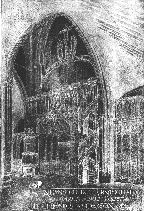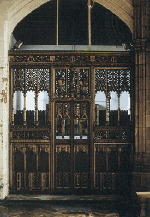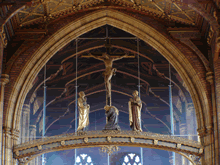History
The most recent history of All Saints Church can be found on our Facebook site, but history going back beyond the most recent decades is below split across several pages.
St. Aidans 1910 - 1969
In 1910, some seventeen years after the first dedication, a new phase was entered during which some of the now familiar and much loved decorative features were added to the church building under the supervision of Frederick Bligh Bond and his partner Ellery Anderson. Although we do not have an account of Fr Newell Long's overall vision for the decoration of the church, we can see its component parts through correspondence with the architect and in the context of the Faculty Petition in which the PCC petitioned 'To erect and place a Rood screen in the chancel; to place new choir stalls in the chancel; to remove the present organ for the purpose of rebuilding the same in a new chamber; to place screens in the arches north and south of the choir'. In a separate faculty petition changes were also proposed and carried through for the Lady chapel where a new reredos was installed.

In fact Canon Long with Bligh Bond had a far more extensive scheme in mind to place a highly elaborate screen and loft across the entire chancel arch and to put a further elaborate and intricate scheme over the entire east end wall but none of these came to fruition. The proposed chancel screen had a decorated spiral staircase to a balcony/loft above, with the Rood beam over. The north (Lady chapel) and south aisle (Guild chapel) are shown as having similar screens. The present screen to the Guild chapel was added in 1914, designed by Bligh Bond. It had been intended to have been coloured, as is the Lady Chapel screen, but the outbreak of war prevented this and it has never been completed. The central screen was never carried through to completion and the chancel arch remains open to this day.
An extensive scheme for a new east wall reredos was also designed at this time and detailed designs can be seen from archive correspondence. The intention was for a highly intricate carved screen to the height of the east window, containing numerous niches with statues of apostles, the whole in Perpendicular style. At the centre, replacing the then existing reredos picture, was to have been either a crucifixion or a Christ in Triumph.
None of this was achieved and it was therefore only the Rood Beam and figures that were placed in 1910-1912. They are striking and beautiful and have been an important part of the church's devotional life since then.
At the same time, in 1910-1912 the Lady Chapel was created. Previously the organ had stood on the floor in the area now occupied by the Lady Chapel, beneath the great arch that occupies the north side of the chancel. In the new scheme, the organ was raised to a loft above and rebuilt and the Lady chapel created below.

Within the Lady chapel a new reredos, the work of Martin Travers and Robert Hitch, was created and commemorates Thomas Proud, the architect. The sacrament, which had not been reserved until the completion of the Lady chapel, was now reserved in the aumbry within the reredos. The beautiful coloured entrance screen to the Lady chapel was also put in place.

1921, a quarter of a century and a World War after the dedication of the church, a further stage was reached. There had clearly been some dissatisfaction with the east end decoration, evidenced by Fr Newell Long's attempted earlier scheme with Bligh Bond. There seem to have been a variety of earlier attempts to find a decorative scheme for the east end wall and these - which include some form of embossed decoration, can be seen in the early photographs of the church.

In October 1921, a new reredos was put in place and dedicated. It is free standing and seems like the rood beam originally intended to have been part of a much larger scheme covering the whole of the east end wall. According to a newspaper report of the time: 'when the rest of the work is carried out it is proposed that the space above the reredos shall be covered with carved niches containing figures of the remaining eight apostles. Kneeling beneath the Agnus Dei are two beautifully carved figures of St Aidan and St Augustine, thus perpetuating the idea of the picture formerly placed above the altar in memory of Fr James Pollock'. This earlier picture can be seen in the photographs. Fr Long left the parish shortly after the dedication of the reredos and although there continued to be correspondence nothing further was ever done.